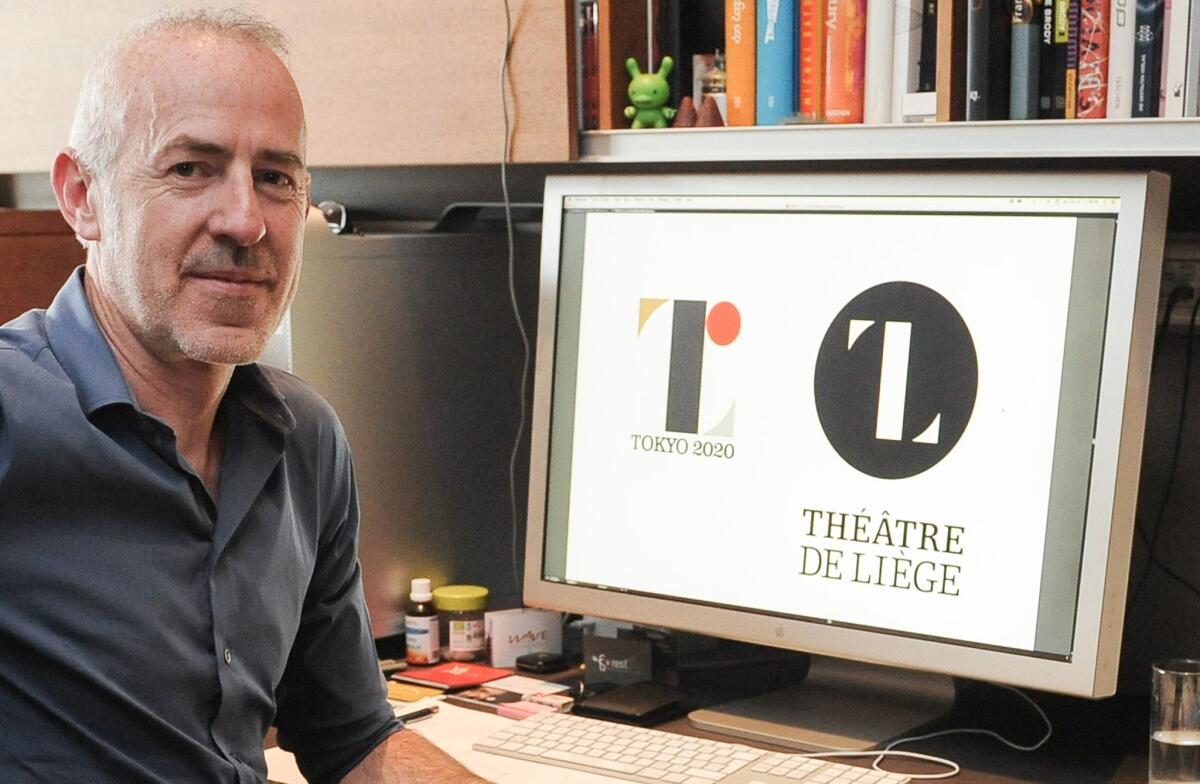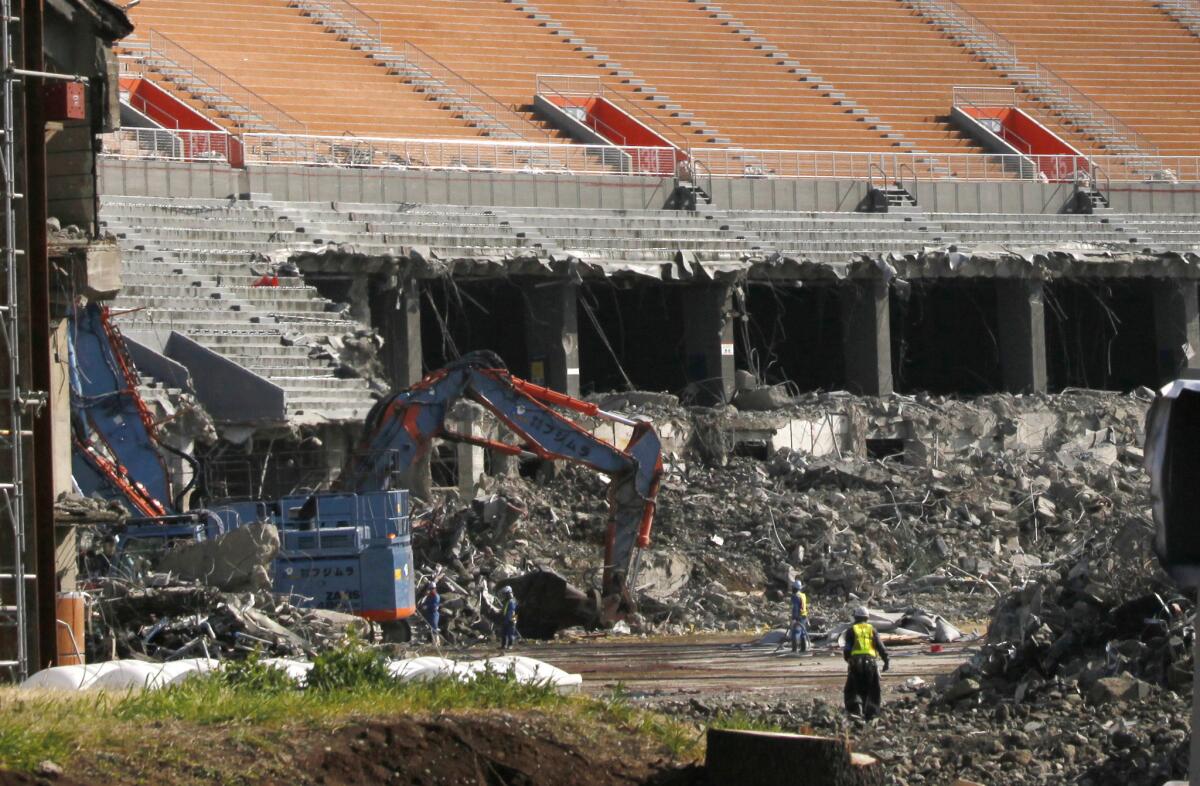As L.A. eyes 2024 Olympics, Tokyo struggles to plan 2020 games
- Share via
As L.A. looks to lure the 2024 Summer Olympics, it’s worth taking note of how plans for the 2020 Summer Games are coming along in Japan. In a nutshell? Not so smoothly.
Sure, the Tokyo Games are still more than four years away, but Japan seems to be struggling to get things on track. Over the summer, organizers scrapped plans for a $2-billion main Olympic stadium design by Pritzker Prize-winning architect Zaha Hadid. Then in September, the emblem chosen by the organizing committee were withdrawn by its Japanese designer amid accusations of copyright infringement.
Why the hiccups? Here’s a look at some of the problems.
What happened to Hadid’s stadium plans?
Hadid’s design called to mind a Rebel Alliance spacecraft out of “Star Wars,” frozen in a holding pattern in the concrete jungle of Tokyo. With a seating capacity of about 80,000 and total floor space of more than 71 acres, plans were for the new structure to replace the main stadium for the 1964 Tokyo Olympics in the heart of the Japanese capital. The old structure was torn down in May, and the site has been ready for the new stadium construction.
The Japan Sport Council chose Hadid’s design in 2012 from 46 entries, and at the time the cost was estimated at $1 billion. But this year, Japan’s government estimated it would actually be more than $2 billion.
See the most-read stories this hour >>
That prompted an outpouring of criticism; even Oscar-nominated actor Ken Watanabe voiced skepticism. “It’s strange news that Japan wants to surprise the world by trying to build a gymnasium that will continuously need a lot money when the country itself carries enormous debt and needs to balance its books,” he wrote in Japanese on Twitter. His note was retweeted 26,000 times and was marked a favorite by 12,000 users.
In mid-July, Prime Minister Shinzo Abe ordered a do-over. “We are going to go back to a clean slate and start from scratch,” he said.
Hadid did not respond to requests for comment. In a statement, Hadid’s firm said the “selection of a limited number of construction contractors” may have been contributed to a less-than-ideal “commercially competitive process” and, as a result, there was an “overly high estimate of the cost of the construction.”

This file photo taken on July 30, 2015 shows Belgian designer Olivier Debie posing for a photo in his office in Liege as his computer display shows Tokyo’s 2020 Olympic emblem, left, and the logo of the Theatre de Liege. Tokyo’s 2020 Olympics organizers scrapped the event’s logo after it drew plagiarism claims.
Belgian designer Olivier Debie’s office computer displays Tokyo's 2020 Olympic emblem, left, and the logo of the Theatre de Liege on July 30, 2015. Tokyo's Olympic organizers scrapped the emblem after it drew plagiarism claims. (AFP / Getty Images)
What was the brouhaha over the emblem?
Amid much fanfare, the Tokyo Olympic organizing committee announced in July that it had chosen Tokyo-based designer Kenjiro Sano’s logo as the winning emblem from 104 entries.
With gold and silver triangular shapes flanking a black rectangle and a red circle symbolizing Japan, Sano’s emblem was simple yet sophisticated. But Belgian designer Olivier Debie, who created a logo for a theater in the city of Liege, east of Brussels, cried foul. Debie said Sano’s work bore an uncanny resemblance to his logo of one rectangle and two triangular shapes and filed a lawsuit against the International Olympic Committee alleging copyright infringement.
On Sept. 1, Sano withdrew his design and said on his website, “I pledge there was no copying or plagiarism.” Sano said that the news media had been knocking on his door day and night and that he was exhausted from the attention.
On the same day, the Tokyo organizing committee said in a statement that the “emblems were withdrawn” and that new policies would be announced shortly.
Ryohei Miyata has been heading the panel within the organizing committee to sort out the new emblem selection process. His committee has decided to allow anyone living legally in Japan who is over the age of 18 to submit entries. (The initial competition was limited to award-winning professional Japanese designers.)
NEWSLETTER: Get the day's top headlines from Times Editor Davan Maharaj >>
Miyata said he didn’t want to “talk about the past” with Sano’s emblem and was focused on finding a new design. “We want artists to submit emblem ideas without feeling there are too many constraints,” he said.
Submissions can be made online for several weeks beginning in late November.
The new guidelines say the logo should be adaptable to a variety of uses on goods such as pins, banners, T-shirts and mugs. Tokyo-based design consultant Coco Funabiki said that when a design consists of simple parts and shapes as Sano’s did, it can be easier to replicate on products — but that the simpler the design, the easier it is for others to claim plagiarism.
Kensaku Fukui, an attorney at Kotto Dori Law Office in Tokyo, said industrial designs such as those used for the Olympics are increasingly tangled in copyright infringement lawsuits.
“Relatively simple designs such as the ones submitted by Sano can have similar designs out there,” said the lawyer, who specializes in copyrights.
Has Japan settled on a new stadium design?
Officials are considering proposals and plan to make a decision by December. This time, the stadium construction budget has been capped at about $1.27 billion, well below the more than $2 billion the government said Hadid’s design would have cost.
Nevertheless, Tokyo’s stadium will still be more expensive than recent host cities’ outlays. London’s main Olympic stadium reportedly cost about $438 million, and Beijing’s Bird’s Nest $414 million.
Shogo Yadomoto, deputy department director at the Japan Sport Council in Tokyo, said it will be a challenge to compress the competition and planning process into several months.
Japanese news media have reported that only two architect-construction-company teams are submitting plans and that the bidding process for the stadium may not be competitive. Yadomoto said he could not discuss how many parties were involved or who has applied to build the stadium.
Although small construction companies were welcome to bid, only the largest construction companies in Japan realistically have the capabilities to pull off a project of this scale in the given amount of time, Yadomoto said.
Architectural economist Takashi Moriyama said he believes even the revised parameters for the stadium are unnecessarily grand. The proposed floor space was downsized from Hadid’s 71 acres to 48 acres, but it is still almost twice that of the main stadium for the 2012 London Olympics, which was about 27 acres.
“The stadium can be much more compact,” and the large scale is resulting in the high cost, Moriyama said.
Yadomoto defended the budget. “Leading up to the Olympics, there is a lot of construction work scheduled and demand has been outstripping supply,” he said. “Unfortunately, we have not been in a position to be able to bargain for the lowest construction fees.”

In this March 5, 2015 photo, workers dismantle Japan’s old National Stadium for the renovation as Japan hosts the 2020 Tokyo Olympics.
Workers on March 5, 2015, dismantle Japan's old National Stadium in Tokyo to make way for a new venue for the 2020 Olympics.(Associated Press)
How are the Olympic Games affecting Tokyo?
The effect of the games is already being felt in the capital. Hotel Okura, widely considered a landmark, tore down its modernist 1962 main building in May amid substantial outcry.
British lifestyle magazine Monocle even tried to save the building by collecting petitions to stop demolition plans; the publication cited the architecture’s historical value for Japan. Celebrities such as Michael Jackson and Madonna and heads of states including U.S. presidents had stayed at Hotel Okura.
The hotel will invest about $828 million to rebuild by 2020 with 550 rooms, about 30% more than the previous capacity.
Meanwhile, the Transportation Ministry has been trying to make the country more accessible. For example, all train stations with at least 3,000 users daily are getting elevators or slopes installed in places where there were only stairs between the train entrance and the platform. Work on 85% of nearly 3,000 stations has been completed, according to the government.
In addition, the government is supporting projects that will showcase the country’s tech prowess.
In May, Robot Taxi was started as a joint venture between robot maker ZMP and video game developer DeNA; it plans to operate driverless taxis by the time of the 2020 Olympics.
Nagano is a special correspondent.
ALSO
A big setback for India's Narendra Modi
Aung San Suu Kyi's party rises to early lead in historic Myanmar election
Miss World Canada, outspoken on rights, says China wants her out of pageant
Sign up for Essential California
The most important California stories and recommendations in your inbox every morning.
You may occasionally receive promotional content from the Los Angeles Times.






